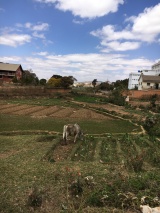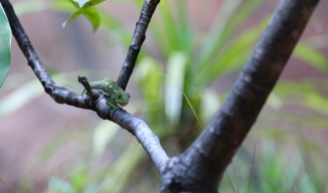I landed in Madagascar’s capital, Antananarivo, at about 11pm, but it was nearly one before I had purchased my visa, cleared passport control and collected my luggage. The airport involves lots of chaotic queues. First to clear the health check (just a man checking the form you have completed confirming you do not have a fever), followed by a queue to purchase a visa, and then that for passport control. This involves having one’s passport taken and added to a pile. You then have to wait until they call your name to recover your passport, before joining a scrum to retrieve your luggage. I then fought my way through a throng of porters and taxi drivers, resisting all attempts to take my suitcase until I spotted my driver. I had to try to remember to resist gently, as Madagascans are sensitive (but at the same time rather pushy), whilst being firm. I did at least succeed in hanging on to my suitcase. Fortunately the hotel was a short drive from the airport, and I was soon united with my friend and travelling companion Andrew and could get some rest after my long flight via Paris.
Daylight revealed a motel style layout to the hotel, with a collection of single story buildings, a rather nice pool and a large restaurant. Tana (to use the nickname for the capital) is very hilly, and is at altitude, sitting in Madagascar’s central highlands. It was sunny but rather cool in the shade, and chilly at night. Our guide for the day, Adza, collected us and drove us through the narrow streets of Tana towards the Lemurs’ Park. Tana’s streets are narrow and chaotic, lined with stalls facing the skinny pavements. The stalls sell all manner of things, including fresh meat, which must stop being fresh quite quickly as it hangs unrefrigerated from the stalls. We passed beside many rice paddies at different stages of cultivation; some being planted, some being ploughed by zebu cattle and some being picked. Cattle egrets and geese dotted the water. As we drove along the Ikopa River we could see the local brick-making industry. The clay is dug from the river and the bricks shaped and fired right on the bank. The traffic was heavy and comprised cars, trucks, scooters, zebu carts and hand drawn carts. There were also a number of earnest cyclists attacking Tana’s many hills.
The Lemurs’ Park is a tiny five hectare reserve south west of Tana. It is made up of families of lemurs confiscated from the illegal pet trade and their descendants. It is well run, and staffed with knowledgeable guides who talk about the local flora as well as the lemurs and chameleons in the park. As it is so small there is not enough natural food for the lemurs, so they are fed. As a result they more or less stay put and are very habituated to humans, so are very easy to see and to photograph. We saw Coquerel’s sifaka, the ring tailed lemurs of King Julian fame, and the doggy black and white ruffed lemur. At one stage a family of the latter set off an impressively loud alarm call, which did not seem to bother the sifaka family we were looking at in the slightest. I spent quite some time photographing the baby sifaka and its family, all of whom have a faintly puzzled expression, like they are slightly stoned.

Coquerel’s sifaka baby
As we stood and watched the ring tailed lemurs with another group of tourists, one came right up to us, causing a toddler to try to embrace it, much to the consternation of both her parents and the lemur. The tour also included a visit to some small cages housing some nocturnal lemurs. This was a bit sad and unnecessary. They are kept this way so they can be shown to the visitors, but of course they are curled up and asleep, so there is not much to see, and the poor creatures would be better in the relative freedom of the reserve.

Ring tailed lemur
After the tour, we passed through central Tana to the old station for lunch at the Cafe du Gare. Pleasant, although there were some rather odd flavour combinations. Mozzarella, tomato, pesto and mustard?
On the way back to the hotel, Adza broke the news that our Air Madagascar flight the following day had been postponed from the morning to 3.30 in the afternoon. This put rather a dent in our day, as it did not give us enough time to do anything before the flight, as the Monday traffic in Tana can be extreme and the hotel was near the airport rather than in the centre.
Andrew and I decided to go for an evening stroll before dark. This is probably not an activity for the faint hearted, as we wove through crowds of people along the tiny pavements, past the many stalls. At one stage we braved a quiet unpaved side road, where we passed three small boys. As we were looking out onto a vineyard at the end of the road, some dogs appeared and barked at the boys, chasing them off so abruptly that one fell full length in the dirt. Those clever kids used us as a shield when we returned, putting us between them and the direction from which the dogs had come, with much giggling. The dogs did not reappear (I rather got the impression they were chasing the kids for a bit of sport rather than with any real intent) and we continued our walk rather uneventfully.
Having survived our walk the previous day, we went for another walk the following morning before our flight. Once again we braved the crowded pavements of the main road into Tana before finding a quieter side road to walk down. We saw a skinny chicken chase a large rat who turned tail and fled, and fields planted with crops behind a tethered zebu. Despite warnings about safety in Tana, we were not bothered at all, and indeed a number of locals greeted us as we wandered past. Eventually we returned to the hotel, before embarking on our flight to Morondava on the west coast.
At the airport I took the opportunity to exchange some euros into Madagascan ariary. A tip for travellers to Madagascar is that you need places to the store your cash. As there are not many places to exchange cash you will probably end up exchanging all your spending money at the airport at the start of your trip and leave with large bundles of cash. You will also get a better rate for higher denomination notes, so a €100 note is worth more than five €20 notes. As a result, try to book and pay for as many things as possible before you travel, as you cannot always pay with a credit card and carrying lots of cash is not practicable.
















Lemurs are such funny looking fellows. I particularly liked the one with the black face wearing the jacket with the fake fur collar…
Oh yay!! I was ever hopeful you’d write. xx